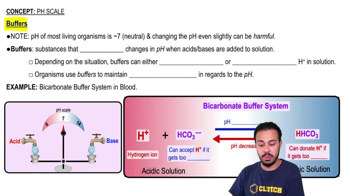pH Scale quiz #1 Flashcards
Terms in this set (11)
What is the typical pH value maintained by most living organisms?
Most living organisms maintain a pH value around 7, which is neutral.
Why is it harmful for living organisms if the pH changes significantly?
Significant changes in pH can be harmful because they can disrupt cellular processes and homeostasis.
What are buffers and what role do they play in living organisms?
Buffers are substances that resist changes in pH, helping to maintain homeostasis in living organisms.
How do buffers respond when acids or bases are added to a solution?
Buffers resist changes in pH by either accepting or donating hydrogen ions when acids or bases are added.
What is the pH range of the pH scale?
The pH scale ranges from 0 to 14, with 0 being acidic, 14 being basic, and 7 being neutral.
What happens to the pH of a solution if the concentration of hydrogen ions increases?
If the concentration of hydrogen ions increases, the pH of the solution decreases, making it more acidic.
What is the bicarbonate buffer system and where is it found?
The bicarbonate buffer system is found in blood and helps maintain its pH by regulating hydrogen ion concentration.
How does HCO3- function in the bicarbonate buffer system when hydrogen ion concentration is high?
HCO3- accepts hydrogen ions, which increases the pH and makes the solution less acidic.
What does HCO3-do when the hydrogen ion concentration is too low?
HCO3- donates hydrogen ions, which decreases the pH and makes the solution more acidic.


